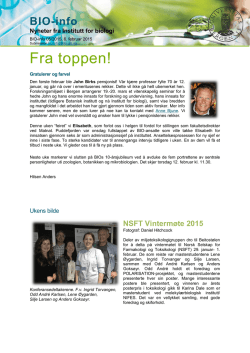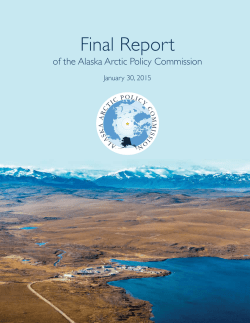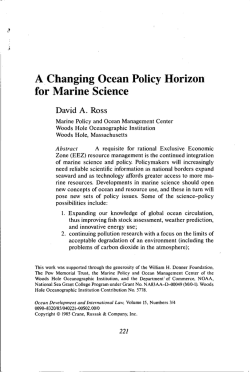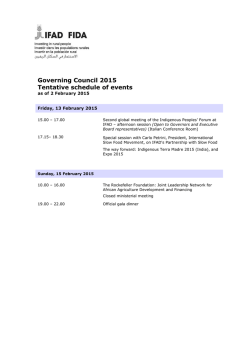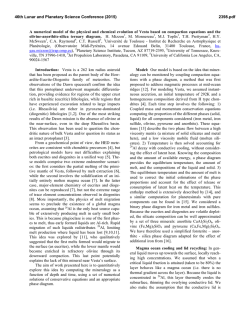
Abstracts available here (PDF)
Arctic Governance ABSTRACTS ••• Options for an Arctic Regional Seas Arrangement Betsy Baker Arctic Ocean Stewardship is one of three proposed pillars of the US Arctic Council Chairmanship 2015-2017. During that time, the United States may propose steps toward a Regional Seas Arrangement for the Arctic, to “serve as a mechanism to coordinate and enhance scientific research and potentially to manage increasing human activity in the Arctic Ocean.” This presentation will analyze how designing an Arctic Ocean RSA presents a prime opportunity to better coordinate observational, monitoring and assessment science from around the Arctic, for use in policy and management decisions. It proposes a scientific advisory body to the Arctic RSA, not to create a new science body but to be a forum for existing Arctic and ocean science groups to share information and advise Arctic Council members, Permanent Participants and Observer states. The advisory body could draw on the work of IASC, the ocean science organizations ICES and PICES and the Sustained Arctic Observing Network (SAON). Other RSAs offer good models for promoting ocean science and basing decisions on it. The North-East Atlantic and the Baltic are relevant models and supported by legally binding agreements known respectively as the OSPAR and HELCOM Conventions. OSPAR, to which all five of the Scandinavian Arctic States are party, includes clear environmental conservation goals and mandates, and covers a significant portion of the Arctic Ocean. HELCOM activity includes monitoring and evaluating environmental indicators. OSPAR and HELCOM cooperate on a range of scientific matters including biodiversity indicators, Marine Spatial Planning, Marine Protected Areas, and Ecosystem Based Management. Such inter-treaty cooperation offers structures with which an Arctic RSA could network and substantive areas for scientific cooperation to inform Arctic Ocean policy around the North. Monitoring protocols for marine pollution under OSPAR’s Joint Assessment and Monitoring Program (JAMP) could serve as best practices for Arctic RSA members. The Incredible Story of the Law of the Sea Michael Byers The SS Manhattan, an US‐flagged ice‐strengthened supertanker, sailed through the Northwest Passage in 1969 without seeking Canada’s permission. The next year, the Canadian Parliament adopted the Arctic Waters Pollution Prevention Act, which imposed strict safety and environmental requirements on all shipping within 100 nautical miles of Canada’s Arctic coast. In doing so, it stretched the limits of international law, which at the time did not recognize coastal state rights more than 12 nautical miles from shore. The United States declared the Arctic Waters Pollution Prevention Act illegal, but Canada carried its initiative into a negotiating process that was just beginning at the United Nations with the goal of producing a globally applicable UN Convention on the Law of the Sea. At a closed‐door session involving the American, Soviet and Canadian delegations only, the three countries negotiated Article 234 of the UN Convention, the so‐called “Arctic exception” which allows coastal states to enact laws against maritime pollution out to 200 nautical miles from shore when almost year‐round ice creates exceptional navigational hazards. The adoption of Article 234 then sparked the development of a parallel rule of “customary international law” that is today regarded as binding on all countries – including those, like the United States, that have not yet ratified the UN Convention. The United States now recommends that US‐flagged merchant vessels abide by the Arctic Waters Pollution Prevention Act when sailing in or near Canada’s Arctic waters. The United States, Soviet Union and Canada also succeeded in advancing their shared interests with regard to ocean resources. Under the UN Convention, each coastal state is entitled to a 12 nautical mile territorial sea as well as an “exclusive economic zone” from 12 to 200 nautical miles where, as the name suggests, it holds exclusive rights over the resources of the water column, ocean floor and seabed. Diplomats also recognized that new technologies and higher prices would eventually lead to the exploitation of oil, gas and minerals more than 200 nautical miles from shore, including in the relatively shallow waters of the Arctic Ocean. They crafted Article 76 of the UN Convention, which accords coastal states rights over an “extended continental shelf” beyond 200 nautical miles, if the depth and shape of the seabed and the thickness of underlying sediments indicate a “natural prolongation” of the shelf closer inshore. Article 76 specifies that the existence of a natural prolongation is a question of science, not technological competence or military might, and it lays out detailed rules concerning the geographical and geological criteria that must be fulfilled. Parties to the UN Convention that wish to claim an extended continental shelf must submit supporting scientific evidence to the UN Commission on the Limits of the Continental Shelf, a body composed entirely of scientists. Countries that have not ratified the UN Convention could assert their rights under customary international law – and outside the UN Commission process – as long as they make their scientific data available for scrutiny by other countries. Consistent with this, the United States has mapped the seabed north of Alaska in partnership with Canada. Everyone benefits from these rules. Coastal states and shipping companies have a clearer legal basis on which to cooperate in the prevention of oil spills and other accidents. And the United States, Russia and Canada, with their enormously long Arctic Ocean coastlines, can each legitimately assert sovereign rights over vast expanses of seabed. Most importantly, countries that do not border on the Arctic Ocean accept the validity of these rules – because they are part of a globally agreed upon package. So the next time that someone says the Arctic is “up for grabs”, or that a new comprehensive treaty is required for the Arctic Ocean, make sure to tell them the Incredible Story of the Law of the Sea. Environmental Governance of The Arctic: Law, Effect, Now Implementation Joseph F.C. DiMento Abstract: This paper addresses how the international community governs the Arctic and whether that community or parts of it should be governing it differently. Its core is analysis of programs specifically created to protect and manage that regional sea. More broadly, it presents the great range of policy and regulatory activity which focuses on the environmental quality of the region. The aim is not only to describe and evaluate existing governance structures but also to indicate how governance can be improved. One approach emphasized, rather than or in addition to working on more international initiatives, is to focus on implementation of the myriad, almost paralyzing, existing international legal obligations. Implementation is addressed in the organizational studies context. Implementation in the legal sense of executing international law into domestic systems is the starting point for our focus on implementation. The research is based on a multi-disciplinary literature analysis, field visits and policy maker and scientific and legal expert interviews. The Legal Regime for International Shipping in Arctic Waters and the Role of the Arctic (Coastal) States Tore Henriksen The five Arctic coastal States have ascribed themselves a stewardship role in the protection of the unique ecosystem of the Arctic Ocean. Preventing operational and accidental pollution from vessels, one of the most serious threats to the Arctic ecosystems, is included. A stewardship role suggests that the states have assumed responsibility to promote the interests of the community of states, through different types of action. It is consistent with the status of conservation of biological diversity as a common concern of human mankind. Conservation of marine biodiversity call for more holistic approaches than provided by the traditional sectoral organization of law of the sea. Can stewardship, where states take on more comprehensive responsibility, be one way of achieving such approach. And is such role compatible with the law of the sea? Other, non-Arctic States have legitimate interests in the regulation of their navigational rights in Arctic waters and in how the marine environment in areas beyond national jurisdiction is protected. This paper set out to investigate what role the Arctic (coastal) States is undertaking in respect of international shipping. It will be based on the initiatives taken by the Arctic States (on the basis of the law of the sea) through national legislation, the Arctic Council and through the IMO (e.g. Polar Code). Some of the questions to be addressed: What kind of stewardship have they or are they planning to perform? How may it be legitimized in international law? Have they promoted the collective interests in protecting Arctic ecosystems or is it pure rhetoric?” Engineering International Environmental Cooperation in the Arctic Brian R. Israel* The Arctic Council’s most recent Ministerial meeting marked the completion of the first cycle of its biennially rotating chairmanship, and the Council’s first sixteen years. A communiqué issued on this occasion memorialized the collective reflections of the eight Arctic States on where the Council has been, and where it might go. As we embark on the second round of chairmanships, we will continue our work to strengthen the Arctic Council to meet new challenges and opportunities for cooperation, and pursue opportunities to expand the Arctic Council’s roles from policy-shaping into policy-making. The intuitive elegance of this turn of phrase—“from policy-shaping into policy-making”—masks the daunting complexity of operationalizing this vision. By identifying environmental challenges and raising their political profile, the Arctic Council has undoubtedly shaped environmental policy. Yet in expanding from collaborative science to assess environmental challenges into collective action to address them, the Arctic Council must navigate a sea of legal complexities. One source of complexity is the division of jurisdiction under international law, and the law of the sea in particular; not all of the conduct contributing to environmental challenges in the Arctic is necessarily within the national jurisdiction of the Arctic States. Moreover, the relevant conduct is frequently private, meaning that a cooperative solution coordinated on the international plane must be translated through multiple governance layers to shape private behavior. Questions of legal form add additional layers of complexity. I propose an analytic framework to aid Arctic States in navigating these complexities and engineering international cooperation to address environmental challenges in the Arctic. *Office of the Legal Adviser for Oceans, International Environmental and Scientific Affairs, United States Department of State. The views expressed are personal and do not necessarily reflect those of the U.S. government. Underlying Premises of the Need for an Arctic Treaty Timo Koivurova Arctic Treaty, sectoral agreements or soft-law instruments – what works and what not? In this presentation, the main intention is to reveal the underlying diversity of assumptions when we aim at advancing integrated ecosystem-based marine management in the Arctic. First, I will explore the reasons why do we see the need for new law to address the vast challenges facing the Arctic waters. It is useful then to first identify the uncertainties in Arctic discourse over what we mean by law/soft-law, since there are number of understandings of what law/soft-law is, the diversity which is problematic from the perspective of having common dialogue over these issues. Various conceptions of law/soft-law are in international level related to different understandings of what law in general and international law in particular is (its enforceability etc.). And yet another problematic issue is how our various conceptions of law/international law, relate to what we see as effective in terms of achieving the goals of integrated ecosystem based management (different notions of law/soft-law carry with them many times different expectations of how they are implemented, expectations that are rarely empirically tested in any way, so they remain assumptions). Another set of diverse assumptions we find when we start discussing an overarching Arctic treaty, which is amenable to various misunderstandings. The underlying premise of the presentation is that by clarifying what we mean by law/softlaw (and associated notions what works in reality, what not), or sectoral/holistic governance, it is possible to discuss more clearly why we are advocating one or another way of advancing integrated ecosystem-based management in the Arctic waters than another – a goal that is shared by many in the field (also those perceiving the current sectoral hard-law strengthenings as the best possible solution). Sovereignty Over Land and Sea in the Arctic Region Tullio Scovazzi Abstract: The major issues sovereignty over land in the Arctic region have been settled by the treaty concerning the Archipelago of Spitzbergen (Paris, 1920) and the judgment by the Permanent Court of International Justice on the dispute between Denmark and Norway on the legal status of Eastern Greenland. Open question of sovereignty over marine spaces exist as regards the straight baseline systems of some polar States, the Norwegian 200-mile fishery protection zone around the Spitzbergen, the submission for the establishment of the outer limits of the continental shelf beyond 200 n.m. made in 2001 by the Russian Federation and a number of maritime delimitations between the neighbouring States concerned. The Arctic Council at Twenty: How to Maintain Effectiveness in a Rapidly Changing Environment Oran R. Young The Arctic today differs profoundly from the Arctic twenty years ago at the time of the transition from the Arctic Environmental Protection Strategy to the Arctic Council. In another twenty years, conditions prevailing in the region are virtually certain to have changed again in significant ways. The major changes occurring over the past twenty years are biophysical (e.g. the recession and thinning of sea ice), economic (e.g. the increased accessibility of Arctic energy resources), and political (e.g. Russia’s renewed aspirations to great power status) in nature. A common feature of these changes is that they are strengthening the links between what happens in the Arctic treated as a distinct region and what happens in the overarching global system. How are these changes affecting the role of the Arctic Council, and how can the council’s members position this body to maximize its effectiveness under changed and changing circumstances? This article seeks to answer this question. In the process, it touches on a range of topics, including the legal and political status of the council, the scope of the council’s mandate, links between the council and other intergovernmental bodies, and the administrative and material resources needed to enhance the effectiveness of the council. The concluding section identifies a range of changes that may unfold in the coming years and asks what impacts they are likely to have on the operation of the Arctic Council. Satellite Session on Community-Based Science in the Arctic Saturday, January 31, 2015 p.m. ABSTRACTS ••• Elizabeth Mendenhall, Department of Political Science, Johns Hopkins University, U.S.A. Social Understandings of the Arctic Domain This project surveys academic and popular discourse about the geophysical transformation occurring in the Arctic, and its implications for international politics. The ice cap is melting much faster than initially predicted, and our collective grasp of what this means for the region, and for us, has been substantially delayed and confused. Five major clusters of metaphors representing the “New Arctic” are visible in popular discourse: the Arctic as “victim,” “test case,” “gold rush,” “strategic arena,” and “pivot area.” These metaphors, and their associated understandings of the region, are constructed from pre-existing images of the Arctic, combined with reactions to new information about this extremely under-researched domain. Drawing on geopolitical theory, the project evaluates each of the major “New Arctic” metaphors for its congruence with what we know about how the region is changing. The assumption is that collective understandings of the region, and what they capture and miss about the changing Arctic, matter for policymaking and institution building in the Far North. The stakes are high, and include the interests of multiple stakeholders, including great powers, indigenous communities, multinational shipping and extraction corporations, and the animals that live on, underneath, or below the dwindling ice cap. May-Britt Öhman, Centre for Gender Research, Uppsala University, Sweden Supradisciplinary conversations on security, safety and resilience in the river valleys of Sábme – land of the Sámi Since 2008 I have combined the study of the (perceived) control of rivers through hydropower and the impacts of the hydropower exploitations during the 20th century within Sábme, the land of the indigenous Sámi people. I apply a methodology which I refer to as supradisciplinarity. My own academic field being History of Science and Technology, the method involves collaboration with different academic disciplines, inviting co-researchers from other academic disciplines; amongst other water resource management, political science, and archeology. Furthermore, I integrate knowledges and people outside academia. This approach goes along with the argument by Donna Haraway, about “situated knowledges” and “partial perspectives” in regard to the production of scientific knowledge. In my interpretation, it also includes the necessity for me as a researcher, and Sámi, to take a stance and not pretend to be “neutral” in front of colonial destructive natural resource exploitation of Indigenous Peoples water- and landscapes. I will describe parts of this work, and the challenges it involves, along with the work of healing that I find equally important. Arn Keeling, Department of Geography, Memorial University, Canada (via Skype) Aboriginal Communities and the Environmental Legacies of Extractive Development in the Arctic In spite of at-times hyperbolic contemporary rhetoric around Arctic resources and the “new North,” the globe’s northern latitudes have been subject to industrial resource-extractive activities for at least a century. Increasingly, scholars (and others) are drawing on these historical experiences to inform contemporary development decision-making, particularly surrounding environmental protection and the (beneficial) participation of Northern indigenous peoples. Yet the long-term environmental legacies of past industrial activities are less well-explored. While community and regulatory concern over the ongoing impacts of historic extractive developments has (in some cases) spurred efforts to clean up contaminated sites, these efforts are typically framed as technical exercises. However, the incorporation of local knowledge and participation in remediation policy and practice, particularly involving Indigenous people, represents an important but understudied aspect of extractive development. This presentation draws on insights and experiences gleaned from a multi-site, collaborative research program in Northern Canada, focused on abandoned mines and aboriginal communities. The project has included oral history and ethnographic research in northern communities, as well as archival research and fieldwork at abandoned sites. The results highlight the critical importance of local/indigenous knowledge and experiences in regulatory reviews and contemporary public debates around industrial development and the remediation of abandoned sites. Mark Vardy, Department of Sociology, Queen's University, Canada Constructing the “stakeholder” in Arctic science-for-policy This paper details how the category of “stakeholder” was constructed by a group of scientists, policymakers and academics as they created a framework to guide research into Arctic change during a three-day workshop. Drawing on transcripts of discussions that took place in the workshop and texts its participants produced, the paper details the reasoning strategies that the participants developed to include and frame “stakeholder” in a particular way. “Stakeholder” can be understood as what ethnomethodologists call an “indexical” term, one that is indexed to the specific context of the workshop. But “stakeholder” can also be understood as what Latour called an “immutable mobile”, able to circulate in networks of Arctic science-for-policy precisely because the specific context that situated the discussion of “stakeholder” is stripped away. In some instances indigenous peoples are included as stakeholders to secure the legitimacy of Arctic science-for-policy, but in other instances the most relevant stakeholders are assumed to be industry. Through an examination of both the conditions in which it was constructed in the workshop and the networks in which it is intended to circulate, this paper argues that “stakeholder” is a key category for understanding the exercise of power in Arctic science-for-policy.
© Copyright 2025

